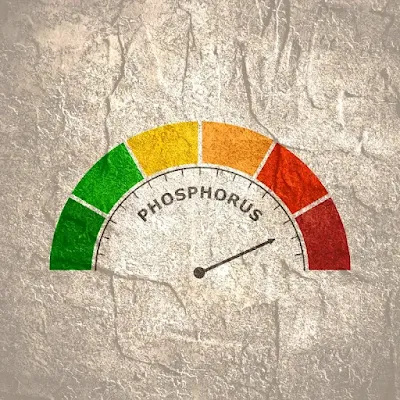Proper management of phosphorus levels is crucial for individuals with chronic kidney disease (CKD) to prevent complications such as bone disease and cardiovascular problems. This guide provides comprehensive strategies for managing phosphorus levels effectively.
Maintaining balanced phosphorus levels is vital for individuals with chronic kidney disease (CKD) to avoid serious complications. High phosphorus levels, or hyperphosphatemia, can lead to bone disorders, cardiovascular disease, and further kidney damage.
Understanding how CKD affects phosphorus balance and adopting effective management strategies can significantly improve health outcomes for CKD patients.
Understanding Phosphorus in CKD
Phosphorus and Kidney Function:
- In healthy individuals, the kidneys regulate phosphorus by excreting excess amounts through urine. However, in CKD, the kidneys' ability to filter out phosphorus diminishes, leading to its accumulation in the blood.
Consequences of High Phosphorus Levels:
- Elevated phosphorus levels can lead to secondary hyperparathyroidism, where the parathyroid glands produce excess parathyroid hormone (PTH) to regulate calcium levels, leading to bone resorption and weakening.
- High phosphorus levels can also cause vascular calcification, where calcium deposits in blood vessels increase the risk of cardiovascular events such as heart attacks and strokes.
Dietary Management
Phosphorus-Restricted Diet:
- Identify High-Phosphorus Foods: Foods high in phosphorus include dairy products (milk, cheese, yogurt), meats (especially organ meats), fish, nuts, seeds, beans, lentils, whole grains, and dark-colored sodas.
- Phosphorus Content in Processed Foods: Processed foods often contain phosphorus additives, which are more easily absorbed by the body than naturally occurring phosphorus. Common additives include dicalcium phosphate, disodium phosphate, and phosphoric acid. Reading food labels is essential to avoid these hidden sources.
- Low-Phosphorus Alternatives: Opt for foods lower in phosphorus, such as fresh fruits (apples, berries), vegetables (broccoli, bell peppers), white bread, refined grains, and certain oils. Cooking methods such as boiling can also reduce the phosphorus content in foods like potatoes.
Phosphorus Binders:
- Role of Phosphorus Binders: Phosphorus binders help prevent the absorption of phosphorus from the digestive tract. They bind to phosphorus in the food and are excreted in the stool.
- Types of Phosphorus Binders:
- Calcium-Based Binders: Such as calcium acetate and calcium carbonate, these binders also provide a source of calcium.
- Non-Calcium-Based Binders: Including sevelamer, lanthanum carbonate, and iron-based binders, these are often used to avoid hypercalcemia (high calcium levels).
- Proper Use of Binders: It is crucial to take phosphorus binders with meals as prescribed. Missing doses can lead to increased phosphorus absorption.
Medication Management
Medications That Affect Phosphorus Levels:
- Certain medications, such as diuretics (which can cause dehydration and increase phosphorus concentration) and vitamin D analogs (used to manage secondary hyperparathyroidism), can influence phosphorus levels. Regular review and adjustment of these medications are necessary under the supervision of a healthcare provider.
Potential Side Effects:
- Phosphorus binders can have side effects such as constipation, nausea, and, in the case of calcium-based binders, hypercalcemia. It is important to report any side effects to a healthcare provider for appropriate management.
Dialysis Considerations
Role of Dialysis in Phosphorus Management:
- Dialysis helps remove excess phosphorus from the blood, but it may not be sufficient alone to maintain normal phosphorus levels. The efficiency of phosphorus removal depends on the type of dialysis, duration, and frequency of treatments.
Optimizing Dialysis Treatment:
- Work with your dialysis team to optimize your treatment plan. This may include increasing dialysis frequency or duration, using higher-efficiency dialysis filters, or combining hemodialysis with peritoneal dialysis if appropriate.
Lifestyle and Monitoring
Regular Monitoring:
- Blood Tests: Regular blood tests are essential to monitor phosphorus, calcium, and PTH levels. These tests help adjust dietary plans, medications, and dialysis treatments to maintain balanced phosphorus levels.
- Tracking Trends: Keeping a record of your blood test results and any symptoms can help you and your healthcare provider identify patterns and make necessary adjustments.
Education and Support:
- Patient Education: Understanding the importance of phosphorus management and knowing how to read food labels, make dietary choices, and adhere to medication regimens are crucial for effective management.
- Support Groups and Resources: Joining CKD support groups or seeking resources from organizations like the National Kidney Foundation can provide additional guidance, support, and motivation.
Symptoms of High Phosphorus:
- Symptoms indicating high phosphorus levels include severe itching, bone and joint pain, muscle weakness, and calciphylaxis (painful skin ulcers due to calcium deposits in small blood vessels). These symptoms require immediate medical attention.
Regular Consultations:
- Regular consultations with a nephrologist or dietitian are crucial for personalized management plans. These specialists can provide tailored advice based on your specific condition and progress.
Conclusion
Effective management of phosphorus levels in CKD involves a combination of dietary adjustments, medication adherence, dialysis optimization, and regular monitoring. By taking proactive steps and working closely with healthcare providers, individuals with CKD can maintain healthier phosphorus levels and reduce the risk of associated complications. Prioritize regular check-ups and stay informed about the best practices in phosphorus management to enhance your quality of life.
Proactively managing phosphorus levels is a critical aspect of living with CKD, and with the right strategies, patients can significantly improve their health outcomes and overall well-being. Always consult with healthcare professionals for personalized advice and support.
Join Our Chronic Kidney Disease Channel on WhatsApp!
Join our supportive WhatsApp channel for valuable resources, expert advice to help you navigate your CKD journey!
Why Join?
Stay Informed: Get the latest updates on CKD research, treatment options, and lifestyle management tips.

0 Comments
Post a Comment
Share your views